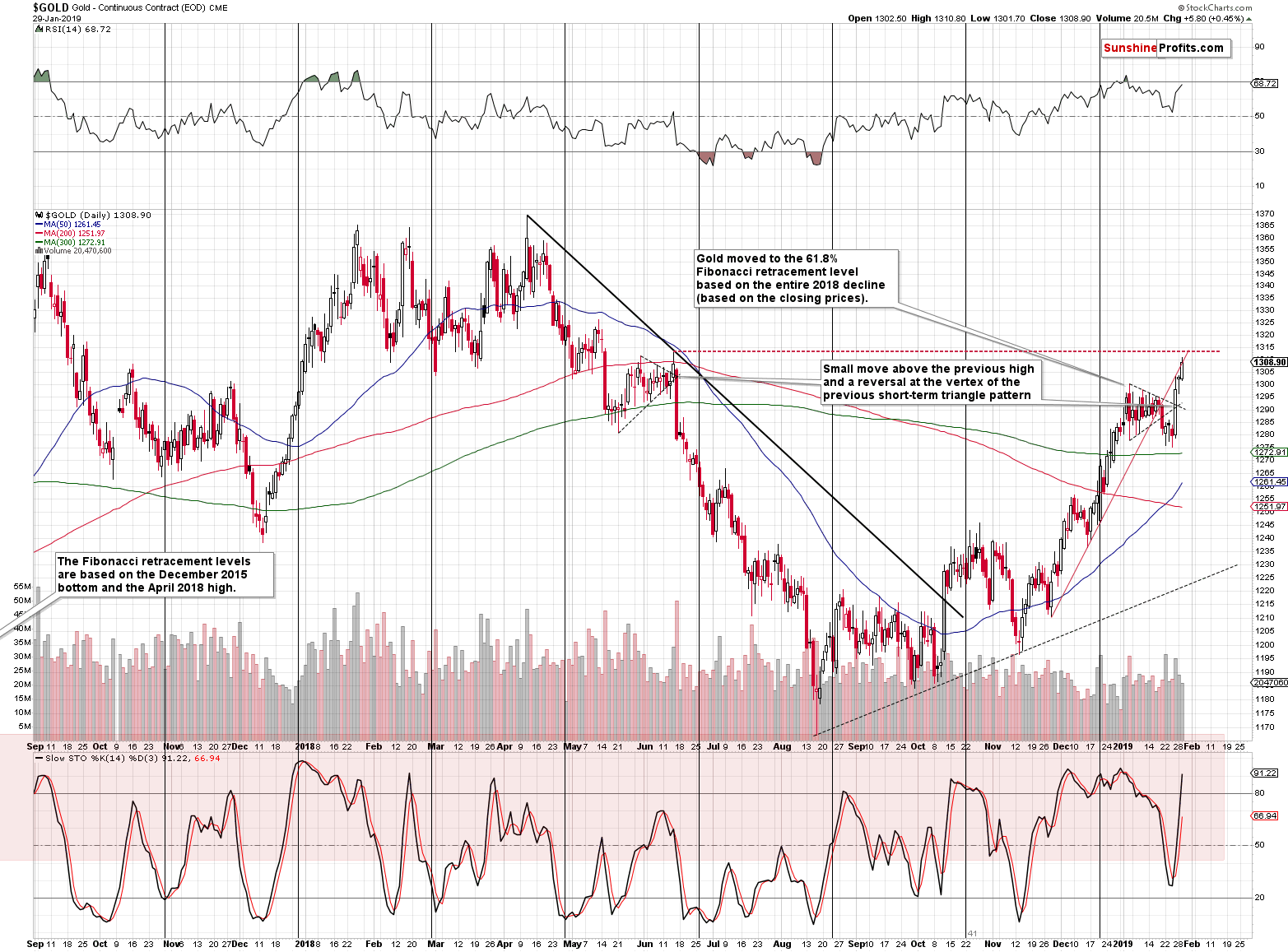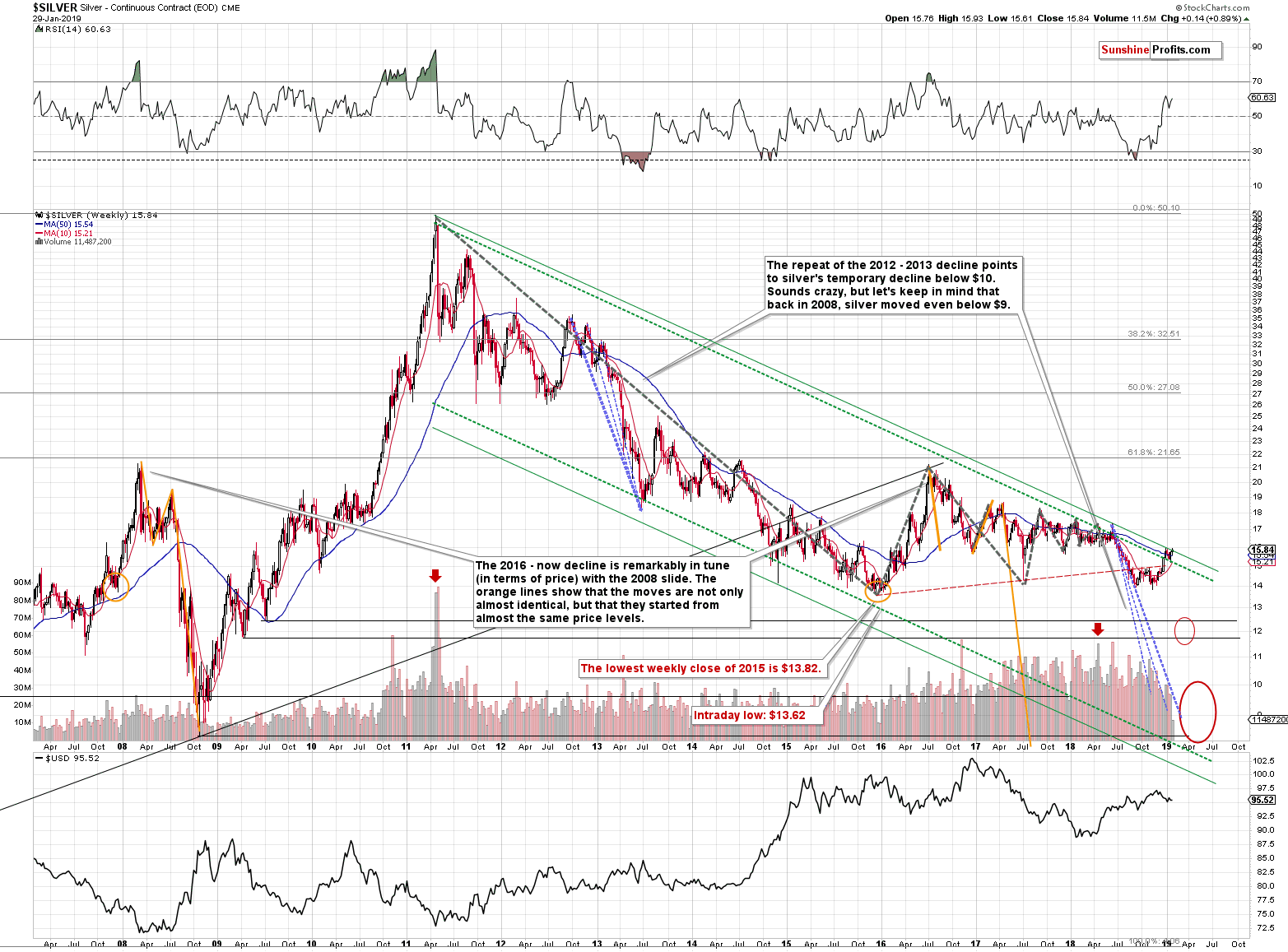Briefly: in our opinion, full (250% of the regular size of the position) speculative short positions in gold, silver and mining stocks are justified from the risk/reward perspective at the moment of publishing this Alert.
In yesterday’s analysis, we described why it was much more likely (than in the previous days) for gold to move higher in the short term and we emphasized that it’s very unlikely to break above its very strong resistance at about $1,315. And that seems to have happened. Gold’s intraday high was about $1,311 yesterday, and it moved to about $1,314 in today’s pre-market trading. Gold’s combination of strong resistance levels remains unbroken.
Consequently, today’s Alert will take form of a follow-up to yesterday’s issue as almost all points made in it remain up-to-date. The changes are mostly present in the silver and mining stock sectors.
Let’s start with gold.
Gold’s Short-term Strength and Its Implications
In yesterday’s analysis, we wrote the following:
Gold managed to stay above the previous 2019 high for the second day in a row and if it manages to do the same thing today, the breakout will be confirmed. This will have bullish implications for the short term.
In yesterday’s analysis, we wrote that the current situation is quite similar to what happened in June 2018. Given the second daily close above the triangle, this is still the case, much less so. There is another analogy, though. Several weeks earlier, in May 2018, gold also rallied above the previous pattern and then stayed there for a second day. It declined shortly thereafter, though. Will we see the same thing this time? It’s quite possible that gold will reverse today, but – especially in light of the pre-market rally - it’s definitely not inevitable.
The thing that will differentiate a bullish outlook for the very short term from a bearish one, will be today’s closing price. So far gold is up in today’s pre-market trading ($1,307), so the indications are bullish.
Based on the above chart, the next short-term target is the June 2018 high, which is a bit below $1,315. That’s not why we’re expecting this level to stop gold’s rally, though.
Please keep in mind that the only thing that we are debating here is the very short-term outlook – none of the above has implications for the medium term, so it doesn’t change the multiple bearish factors that point to much lower gold and silver prices in the following months.
The short-term breakout was indeed confirmed. The fact that we have a combination of very strong resistance levels just a few dollars above yesterday’s high is much more important, though. This line is visible on the two charts below.
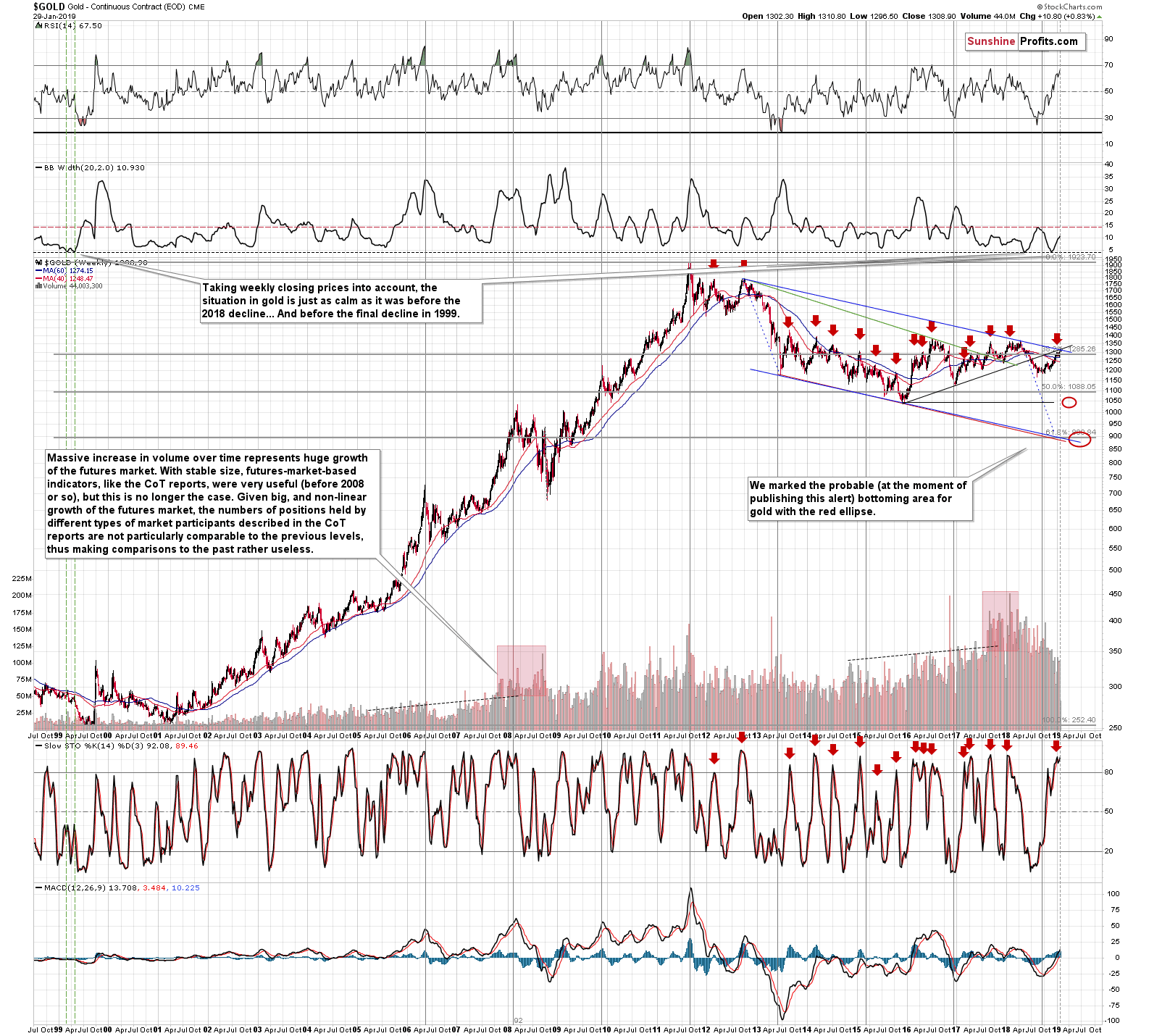
Yesterday, we outlined the following:
The most important declining resistance line that we see on the above chart and one of the most important rising resistance lines are just above the current gold value. Only one of these lines would be strong enough to stop the rally and trigger a major reversal. We have both of them crossing each other for several days. This makes the resistance extremely strong.
This is not only a resistance – it’s the most important of the triangles that we see in gold and gold is just below its vertex. We can’t stress this enough, how important and strong both: the triangle and the resistance lines are. If one was wondering what justifies the position size that’s bigger than usual, the above serves as a critical indication that it is indeed justified.
Let’s take a more detailed look at the above-mentioned resistance levels and the vertex.
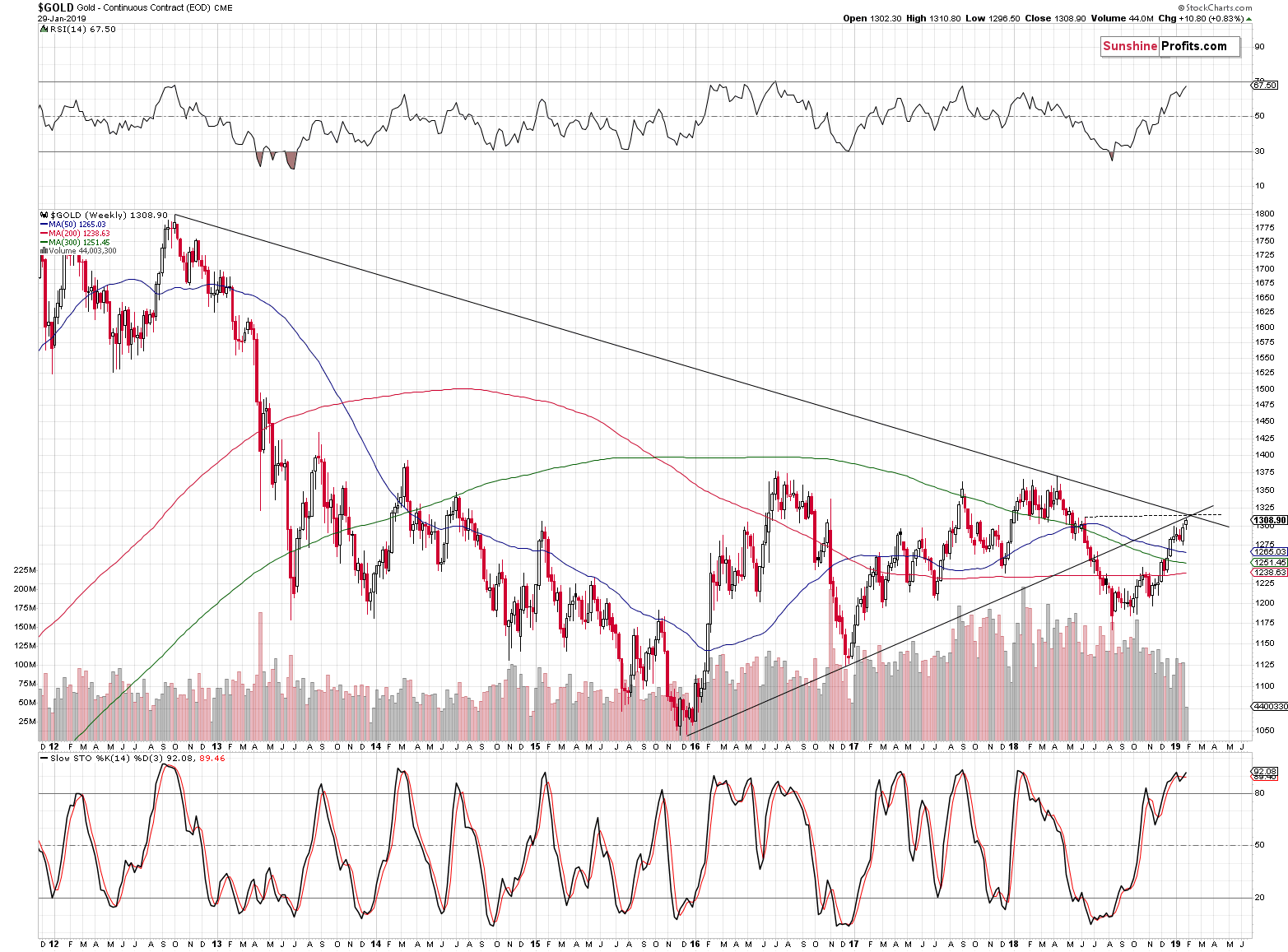
The intersection of the two above-mentioned lines is approximately at the level of the June 2018 high – at about $1,315, which is where gold is most likely heading.
The intersection of both critical lines was almost reached. Gold’s price is so close to it that it’s barely visible on the above chart that it wasn’t reached yet. It seems that we will not have to wait long for the next reversal.
Silver vs. Its Long-term Resistance
Silver jumped $0.23 higher, but, ended yesterday’s session only $0.14 higher. The close was practically at the declining resistance line, so there was no meaningful breakout. The intraday move did take silver temporarily above the resistance, but it was too small and too brief to be anything important.
Let’s keep in mind that silver sometimes tends to provide fake signals, so unless silver’s breakout is confirmed by a one in gold, it should not be trusted. And gold is very unlikely to break above its combination of resistance levels.
What about gold miners?
Gold Miners’ Breakout and Resistance
Gold stocks moved above their previous highs and their next very short-term target is based i.a. on the rising short-term resistance lines. This line crosses the rising support / resistance lines tomorrow and in early February, which further adds to the likelihood that we’ll see a major turnaround shortly.
The upside is very limited. The near-term target based on the above chart is at about 167.
The most bullish development is not the breakout above the previous highs, but above the previous lows.
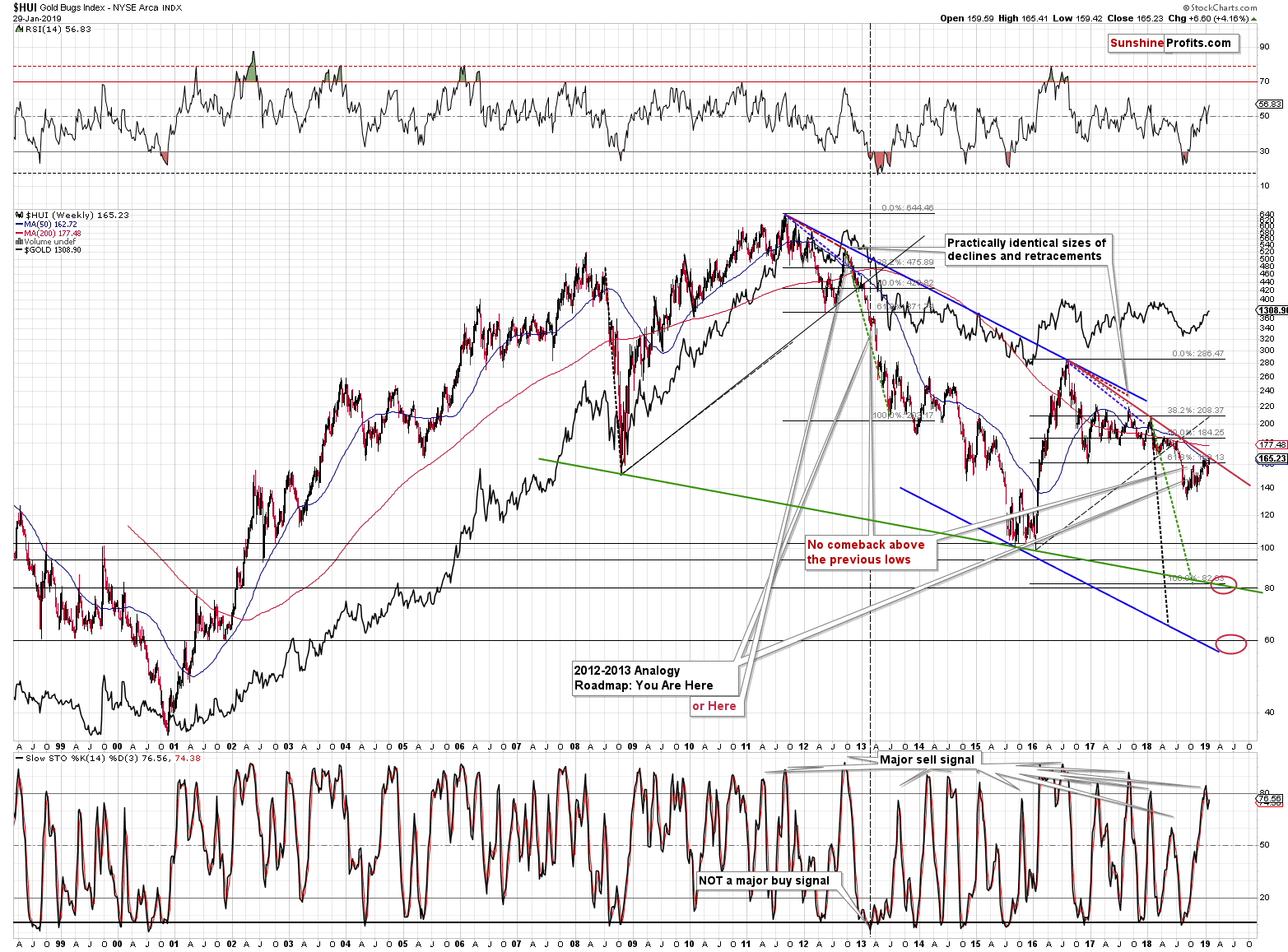
The HUI just closed the day above the lowest close of December 2016. This is a notable development. But just like it was the case with gold, there is a very strong resistance just ahead.
The line based on the 2016 and 2018 highs that we marked with red provides very strong resistance. After all, the more important the highs are that create a given line, the more important and stronger implications it has. This line is not as significant as the two lines that we see on the gold chart, but it’s definitely one of the strongest lines that we have in case of the mining stocks.
On the above chart, it’s not particularly clear where it provides resistance, so let’s zoom in.

It’s at about 167 – 168, which is in tune with what we wrote based on HUI’s short-term chart. It’s only about 2 index points above yesterday’s close, so the upside for gold miners is very limited.
Before summarizing, let’s take a look at the USD Index.
The USD Index and Its Upcoming Reversals
In short, the USD Index appears to be verifying its breakout above the declining short-term resistance line. The breakout was already verified by three consecutive daily closes above this line, so it’s is likely to hold and serve as support. And that’s exactly what happened in the last few days.
The more important thing is what’s likely to happen next, and the above chart is quite clear about that. The USD Index is moving lower on a short-term basis and we have an upcoming reversal that’s based on several vertexes of triangles that confirm each other. If the USD Index continues to decline along the declining support line, just like it did in the past few days, it will reach the reversal at about 95. It’s not too far from yesterday’s intraday low, so it’s not likely to result in any meaningful action in the precious metals market.
To be clear, the USDX doesn’t have to decline until the reversal day – it can just trade sideways and start the rally in the first days of February. The point that we want to make is that a brief move lower to 95 or so would not invalidate anything of the above.
Summary
Summing up, the rally that we were likely to see in gold based on the breakout above the previous 2019 high, has likely already taken place – either entirely, or mostly. The upside for gold remains very limited as $1,315 is where we have two very strong resistance lines and in case of the HUI Index, the very strong resistance is provided by the 167 – 168 area. Silver remains below its long-term resistance line, but let’s keep in mind that if it temporarily broke above it, it would not be meaningful on its own. Without analogous breakouts in gold and HUI, it should not be trusted as it would likely be a fakeout.
The upside remains limited, while the downside remains enormous. The key thing remains to be that the bearish outlook for the following weeks has been confirmed by multiple factors, i.a. silver’s extreme outperformance and miners’ underperformance, gold’s performance link to the general stock market, gold getting Cramerized, and many more. This all tells us that more weakness in the PM market is just around the corner. The number of signals confirming the above and the profit potential of this situation are enormous, especially compared to the very limited upside for the possible corrective upswing.
As always, we’ll keep you – our subscribers – informed.
To summarize:
Trading capital (supplementary part of the portfolio; our opinion): Full short positions (250% of the full position) in gold, silver and mining stocks are justified from the risk/reward perspective with the following stop-loss orders and exit profit-take price levels:
- Gold: profit-take exit price: $1,062; stop-loss: $1,326; initial target price for the DGLD ETN: $82.96; stop-loss for the DGLD ETN $43.47
- Silver: profit-take exit price: $12.32; stop-loss: $16.34; initial target price for the DSLV ETN: $47.67; stop-loss for the DSLV ETN $24.18
- Mining stocks (price levels for the GDX ETF): profit-take exit price: $13.12; stop-loss: $22.03; initial target price for the DUST ETF: $80.97; stop-loss for the DUST ETF $20.37
Note: the above is a specific preparation for a possible sudden price drop, it does not reflect the most likely outcome. You will find a more detailed explanation in our August 1st Alert. In case one wants to bet on junior mining stocks’ prices (we do not suggest doing so – we think senior mining stocks are more predictable in the case of short-term trades – if one wants to do it anyway, we provide the details), here are the stop-loss details and target prices:
- GDXJ ETF: profit-take exit price: $17.52; stop-loss: $32.03
- JDST ETF: initial target price: $154.97 stop-loss: $42.17
Long-term capital (core part of the portfolio; our opinion): No positions (in other words: cash)
Insurance capital (core part of the portfolio; our opinion): Full position
Important Details for New Subscribers
Whether you already subscribed or not, we encourage you to find out how to make the most of our alerts and read our replies to the most common alert-and-gold-trading-related-questions.
Please note that the in the trading section we describe the situation for the day that the alert is posted. In other words, it we are writing about a speculative position, it means that it is up-to-date on the day it was posted. We are also featuring the initial target prices, so that you can decide whether keeping a position on a given day is something that is in tune with your approach (some moves are too small for medium-term traders and some might appear too big for day-traders).
Plus, you might want to read why our stop-loss orders are usually relatively far from the current price.
Please note that a full position doesn’t mean using all of the capital for a given trade. You will find details on our thoughts on gold portfolio structuring in the Key Insights section on our website.
As a reminder – “initial target price” means exactly that – an “initial” one, it’s not a price level at which we suggest closing positions. If this becomes the case (like it did in the previous trade) we will refer to these levels as levels of exit orders (exactly as we’ve done previously). Stop-loss levels, however, are naturally not “initial”, but something that, in our opinion, might be entered as an order.
Since it is impossible to synchronize target prices and stop-loss levels for all the ETFs and ETNs with the main markets that we provide these levels for (gold, silver and mining stocks – the GDX ETF), the stop-loss levels and target prices for other ETNs and ETF (among other: UGLD, DGLD, USLV, DSLV, NUGT, DUST, JNUG, JDST) are provided as supplementary, and not as “final”. This means that if a stop-loss or a target level is reached for any of the “additional instruments” (DGLD for instance), but not for the “main instrument” (gold in this case), we will view positions in both gold and DGLD as still open and the stop-loss for DGLD would have to be moved lower. On the other hand, if gold moves to a stop-loss level but DGLD doesn’t, then we will view both positions (in gold and DGLD) as closed. In other words, since it’s not possible to be 100% certain that each related instrument moves to a given level when the underlying instrument does, we can’t provide levels that would be binding. The levels that we do provide are our best estimate of the levels that will correspond to the levels in the underlying assets, but it will be the underlying assets that one will need to focus on regarding the signs pointing to closing a given position or keeping it open. We might adjust the levels in the “additional instruments” without adjusting the levels in the “main instruments”, which will simply mean that we have improved our estimation of these levels, not that we changed our outlook on the markets. We are already working on a tool that would update these levels on a daily basis for the most popular ETFs, ETNs and individual mining stocks.
Our preferred ways to invest in and to trade gold along with the reasoning can be found in the how to buy gold section. Additionally, our preferred ETFs and ETNs can be found in our Gold & Silver ETF Ranking.
As a reminder, Gold & Silver Trading Alerts are posted before or on each trading day (we usually post them before the opening bell, but we don't promise doing that each day). If there's anything urgent, we will send you an additional small alert before posting the main one.
Thank you.
Sincerely,
Przemyslaw Radomski, CFA
Editor-in-chief, Gold & Silver Fund Manager


